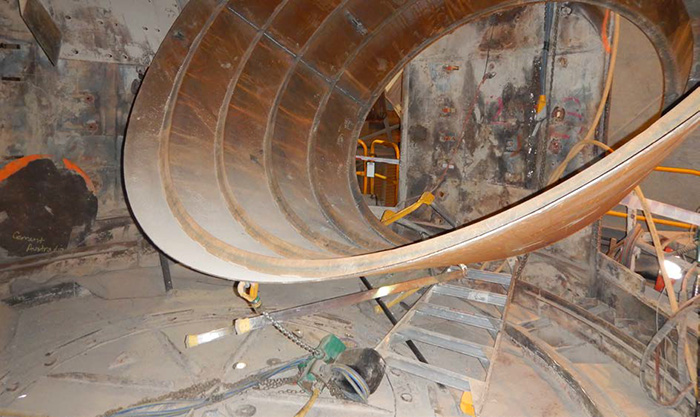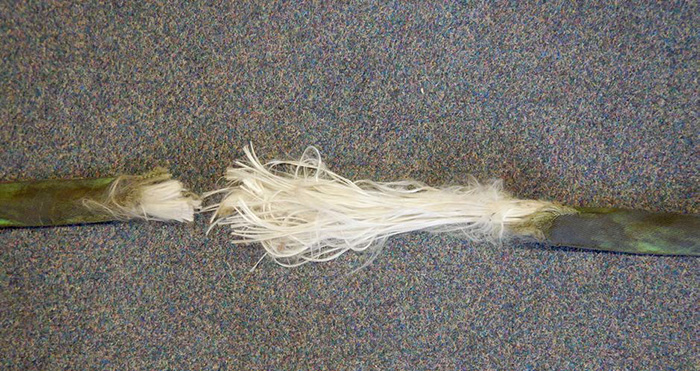In March 2016, a maintenance crew was hoisting a hollow steel cone into position inside a raw material processing mill. The cone (approximately 4m in diameter and around 750kg in weight) was being hoisted from two steel lifting points attached to the inside of the mill, and the rigging at each point consisted of a two tonne soft sling attached to a one tonne chain block, which was coupled to a 500kg air hoist.To protect the soft slings from the sharp edge of the lifting point, welding gloves were placed underneath the slings by the rigger.
The rigging was set up by the day shift rigging crew and the job continued into the night shift with a new crew.
The cone was successfully lifted into position and its level was being checked by a boilermaker prior to welding it in place, when one of the soft slings failed. This caused the cone to swing downwards on the other sling and injure two of the maintenance crew. A third crew member was injured as he jumped clear of the cone.
Fortunately, the injuries were not serious, but given the size and weight of the cone and the restricted area, the outcome could easily have been worse.

Contributing factors
WorkSafe Tasmania’s investigation found two main sets of factors that contributed to the incident: those associated with the sling failing and those associated with workers being within striking distance of the cone when the sling failed.
Failure of the soft sling
- The lift planning process that had recently been introduced was poorly understood by the riggers and supervisors.
- The lift plan that was developed for the job did not contain details of the rigging, and the pre-lift checklist was filled in several days prior to the lift.
- A soft sling was used instead of a steel chain in a situation that exposed it to potential damage from a sharp edge.
- The soft sling that failed was found to have been cut by the sharp edge of the steel structure around which it had been placed (see image below).
- The welding glove used as edge protection had moved out of position and exposed the sling to the sharp edge.
- The night shift rigger had not carried out a close inspection of the rigging before using it.
- An effective handover did not occur between the day shift and night shift riggers to communicate information about the rigging
Crew standing within striking distance of the suspended load
- The safe work procedure for the task did not describe in enough detail how to carry out the job safely without workers putting themselves within striking distance of the suspended load.
- Although the maintenance crew members were experienced tradesmen, they had not carried out the task before and did not receive adequate training or instruction in how to safely carry out the task.
- The supervisor did not check the system of work that had been developed by the crew or supervise the lift.
- The maintenance crew chose to carry out the lift and to check the level of the cone from positions that placed them within striking distance of the cone when it failed.

Recommendations
- Soft slings should not be used in situations where they may be damaged by sharp edges, unless this is absolutely necessary to protect the item being lifted. In such cases, fit-for-purpose sling protection should be used.
- Riggers who are using rigging which has been installed by another person should closely inspect it to ensure that it is safe to use before starting the job.
- Safe work procedures and lift plans should provide sufficient detail to allow maintenance crews to carry out lifting and other jobs without putting themselves within striking distance of the suspended load.
- Maintenance crews, irrespective of their trade experience, should be provided with adequate instruction, training and supervision for them to carry out their tasks safely.
- Workers should not put themselves within striking distance of suspended loads and should intervene if they see other workers in this situation.
- An effective handover should be carried out between crews when rigging tasks extend over more than one shift
- Regular task observations should be carried out on high risk tasks (such as rigging) to check that risk controls are in place and are being used as intended.
Resources
How to manage work health and safety risks code of practice
Safety policies and procedures
Training and supervising your workforce
First published in June 2016
